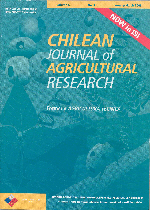
|
Agricultura Técnica
Instituto de Investigaciones Agropecuarias, INIA
ISSN: 0365-2807
EISSN: 0365-2807
Vol. 62, No. 3, 2002, pp. 396-405
|
 Bioline Code: at02037
Bioline Code: at02037
Full paper language: Spanish
Document type: Research Article
Document available free of charge
|
|
|
Agricultura Técnica, Vol. 62, No. 3, 2002, pp. 396-405
| es |
Evaluación de Distintos Métodos de Prevención de Daño Causado por Lagomorfos en Plantaciones de Tagasaste (Chamaecytisus Proliferusssp. Palmensis)
Ovalle, Carlos; Ojeda, Felipe & Skewes, Oscar
Resumen
Uno
de los principales problemas en el establecimiento de una plantación
de tagasaste (
Chamaecytisus proliferus
ssp.
palmensis) es el ataque que las plantas sufren por parte de los lagomorfos
(liebres y conejos). La presente investigación tuvo por objetivo evaluar
métodos sencillos y no contaminantes del medio ambiente, que eviten
el daño causado por lagomorfos en el establecimiento de plantaciones
de tagasaste. Se evaluaron métodos físicos y químicos. Los
primeros fueron dos tipos de cilindros de mallas plásticas y un cerco
eléctrico especialmente diseñado para el efecto; los segundos,
fueron dos repelentes comerciales, Tetrametil tiuram disulfuro y Denatonium
benzoato y timol, además de sangre de bovino tratada con anticoagulante.
Los resultados obtenidos muestran que el cerco eléctrico reduce el
ataque de las liebres en un 100%, de mediana efectividad resultó la
malla tipo bizcocho, siendo la malla tipo hexagonal, los repelentes y la
sangre ineficaces en cuanto a protección.
Palabras-clave
liebres, conejos, protección vegetal, daño por animales silvestres
|
| |
| en |
Evaluation of Different Methods of Damage Prevention Produced by Lagomorphs in Tagasaste (Chamaecytisus Proliferusssp. Palmensis) Plantations
Ovalle, Carlos; Ojeda, Felipe & Skewes, Oscar
Abstract
One of the main problems in the establishment of a tagasaste (
Chamaecytisus proliferus
ssp.
palmensis) plantation is damage produced by lagomorphs (hares and rabbits).
The objective of this research was to evaluate simple, non-toxic methods of
preventing damage to new plantations of tagasaste. The methods evaluated were
physical and chemical. The former were two kinds of plastic mesh cylinders
and an especially designed electric wire fence; the latter were two commercial
repellents, Tetramethyl tiuram disulfur and Denatonium benzoate and timol,
as well as bovine blood treated with anticoagulant. The results showed that
the electric fence reduced the hare attacks by 100% and the thick hexagonal
cylinder was of average effectiveness. The thin hexagonal cylinder, chemical
repellent and blood were ineffective.
Keywords
hares, rabbits, vegetal protection, wild animals damage
|
| |
© Copyright 2002 - Instituto de Investigaciones Agropecuarias, INIA (Chile)
Alternative site location: http://www.inia.cl/at/agritec.htm
|
|
